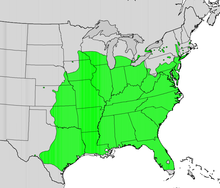- Morus rubra
-
Morus rubra 
The leaf (above) & bark (below) of the Red mulberry tree 
Scientific classification Kingdom: Plantae (unranked): Angiosperms (unranked): Eudicots (unranked): Rosids Order: Rosales Family: Moraceae Genus: Morus Species: M. rubra Binomial name Morus rubra
L.
Morus rubra, commonly known as the Red Mulberry, is a species of mulberry native to eastern North America, from Ontario and Vermont south to southern Florida and west to southeast South Dakota and central Texas. Although common in the United States, it is listed as an endangered species in Canada.[1][2]
Red Mulberry is a deciduous tree, growing to 10-15 m tall, rarely 20 m, with a trunk up to 50 cm diameter. The leaves are alternate, 7-14 cm long and 6-12 cm broad, simple, broadly cordate, with a shallow notch at the base, typically unlobed on mature trees although often with 2-3 lobes, particularly on young trees, and with a finely serrated margin.[1] The upper surface of the leaves is noticeably rough, similar in texture to fine sandpaper, and unlike the lustrous upper surface of the leaves of White Mulberry (M. alba).[3] The underside of the leaves is covered with soft hairs. The leaf petiole exudes milky sap when severed.[4] It is hardy to -25° Celsius (USDA Zone 5).[5]
The flowers are relatively inconspicuous: small, yellowish green or reddish green, and opening as leaves emerge. Male and female flowers are usually on separate trees although they may occur on the same tree.
The fruit is a compound cluster of several small drupes, similar in appearance to a blackberry, 2-3 cm long, red ripening dark purple, edible and very sweet with a good flavor.[1]
Contents
Conservation
The species is threatened by extensive hybridization with the invasive White Mulberry (M. alba), introduced from Asia.[6]
Uses
The first English colonists to explore eastern Virginia in 1607 mentioned the abundance of both mulberry trees and their fruit, which was eaten, sometimes boiled, by the native Powhatan tribes. It remains a widely used as a fruit in pies, tarts, cobblers and raw, in similar fashion to blackberries.
References
- ^ a b c Flora of North America: Morus rubra
- ^ Ambrose, J. D., & Kirk, D. (2004). National Recovery Strategy for Red Mulberry (Morus rubra L.). Ontario Ministry of Natural Resources, Guelph, Ontario, Canada
- ^ Farrar, J.L. (1995). Trees in Canada. Fitzhenry and Whiteside/Canadian Forest Service, Markham, Ontario.
- ^ Trees of Alabama and the Southeast: Red Mulberry, Morus rubra, Moraceae.
- ^ Dave's Garden. PlantFiles: Red Mulberry Tree, Morus rubra
- ^ Burgess, K. S., Morgan, M., Deverno, L., & Husband, B. C. (2005). Asymmetrical introgression between two Morus species (M. alba, M. rubra) that differ in abundance. Molec. Ecol. 14: 3471–3483 pdf file.
External links
 Media related to Morus rubra at Wikimedia Commons
Media related to Morus rubra at Wikimedia Commons  Data related to Morus rubra at WikispeciesCategories:
Data related to Morus rubra at WikispeciesCategories:- Morus (plant)
- Plants described in 1753
- Trees of the Eastern United States
- Trees of the Plains-Midwest (United States)
- Trees of Texas
- Trees of Michigan
- Trees of Illinois
- Trees of Ontario
- Trees of Vermont
- Trees of North Carolina
Wikimedia Foundation. 2010.

